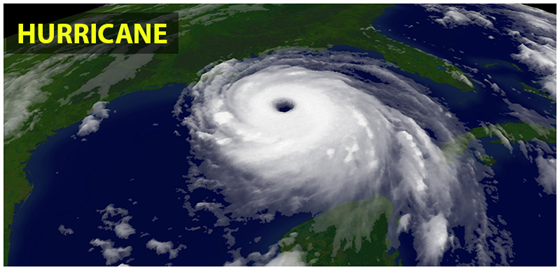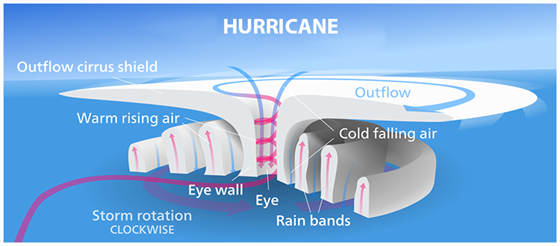
The most violent storms on earth, the hurricane, is formed over the warm ocean waters near the equator. The term “hurricane” is usually used for the large storms that are formed over the Atlantic Ocean or the eastern Pacific Ocean. The more generic and scientific term for these storms is tropical cyclone. Depending on where they are generated, they are referred by several other names such as typhoons and cyclones. No matter what they are called, the same forces and conditions give rise to these storms. When they hit the land where people reside, plenty of damage is caused. In this article, we will be looking into more details of hurricanes.
What is a hurricane?
Hurricanes are enormous storms which come with rotating wind speed of 74 miles per hour. The rotating wind swirls across the warm water of the tropics and comes with terrifying force. This force blast ashore which causes destruction and even death. Hurricanes are known to be one of nature’s most destructive storms as they bring heavy rains, deadly waves and fierce winds. Hurricanes leave its mark by hitting the land, rip up trees, cause floods and destroy homes. Thousands of people get killed with this terrifying storm and cause a million dollars of damage. People get homeless, everything gets swept away by these floods. Another violent wind storm is known as Tornadoes. Tornadoes winds are more violent and stronger than hurricane winds. Hurricanes last longer and cover up to 500000 square miles of land.
How do Hurricanes form?

Formation of Hurricanes
Hurricanes are known to be the most violent storms on earth. Usually, they are formed near the equator over the warm ocean water. Waves are produced when oceans are at their warmest temperature, and the air above water becomes heavy with a lot of moisture. Hurricanes typically form between 5 and 15 degrees latitude north and south of the equator. To learn more, click on the link listed below.
Hurricane Season
The period during each year when hurricanes are most likely to occur in a given place is called hurricane season. Hurricane season lasts from June to October over the Western Pacific and in the Atlantic, it runs from June to November.
Stages of Hurricane:
Hurricanes go through a process of development that involves different stages to become what they are. These stages have different lengths depending on the environmental conditions of the place where they are located at a particular time. If the conditions are favourable, then a hurricane can be formed quickly; likewise, if the conditions are unfavourable, the development can be slow. Given below in a table are the different stages of development that a hurricane goes through:
| Tropical Disturbance | An organised area of thunderstorms that usually forms in the tropics. Typically, they maintain their identity for 24 hours and are accompanied by heavy rains and gusty winds. |
| Tropical Wave | A low-pressure trough generally moving westward with the trade winds. |
| Tropical Cyclone | A generic term for any organised low pressure that develops over tropical and sometimes subtropical waters. Tropical depressions, tropical storms, and hurricanes are all example of tropical cyclones. |
| Tropical Depression | An organised area of low pressure in which sustained winds are 38 mph or less. |
| Hurricane | A tropical cyclone with sustained winds of at least 74 mph. |
| Tropical Storm | A tropical cyclone with maximum sustained wind speed that ranges from 39 to 73 mph. |
Some Interesting Facts About Hurricanes:
There are some facts that are related to the hurricanes:
- Hurricanes are violent storms and can travel up to 300 miles across.
- A hurricane can last for more than 14 days.
- The first hurricane every year gets a name starting with the letter A, second with B, and so on.
- There is a wall of clouds around a hurricane’s eye that is called as the eyewall. The storm’s strongest winds exist in the eyewall.
- The deadliest hurricane in the United States hit Galveston, Texas in 1900. A storm surge 20 feet high rushed through the whole city and more than 8000 people were killed.
Difference Between Hurricane and Typhoon:
Typhoon and Hurricane are the same types of storms. The only difference is in their names. According to geographical position, the name of this storm varies. In the western Pacific Ocean, these storms are called Typhoons whereas in the Eastern Pacific Ocean, the Atlantic Ocean and the Gulf of Mexico they are called Hurricanes. In Australia, Bay of Bengal and the Indian Ocean these types of storms are called cyclones. Learn the difference between cyclone and hurricane by clicking on the link below:
Stay tuned with BYJU’S to learn more about hurricanes, typhoon and much more.




Comments